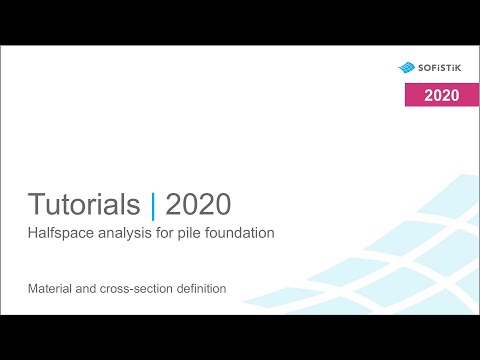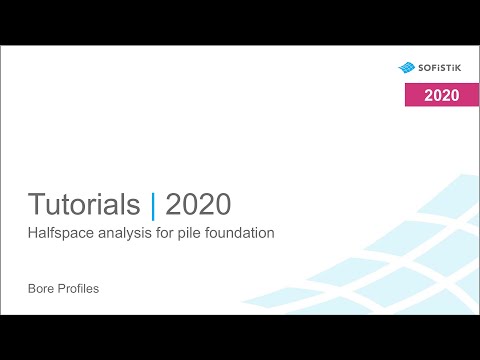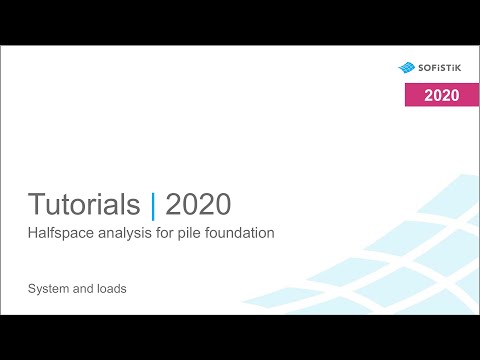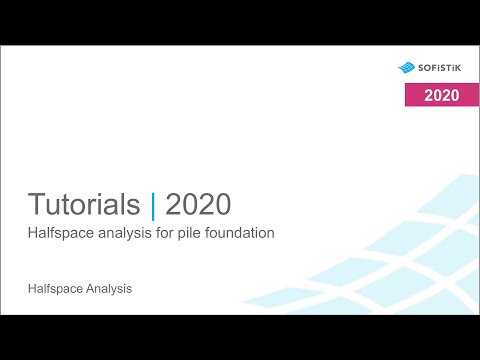Halfspace analysis for pile foundation¶
Introduction¶
The following tutorial describes the basic workflow of the task
“Soil-Structure-Interaction”. Guided by the task, all necessary input will be defined.
For further descriptions and examples please also refer to the HASE manual.
After working through these tutorials, the user should be able to use this task for
further halfspace calculations.
Note
To understand this tutorial, a basic knowledge of the SSD is required. We recommend to see our online introduction videos.
Objectives and workflow steps¶
Start new project
Define materials
Define bore profiles
System generation in SOFiPLUS(-X)
Load generation in SOFiPLUS(-X)
Halfspace analysis
Postprocessing (Results)
Project description¶
Piled foundations can also be analysed using the halfspace method. In this case the pile cross-sections needs to be defined. The 4 piles have a diameter of 80 cm and a length of L = 800 cm. The pile cap thickness is d = 100 cm.
Materials and Cross-Sections¶
Title: Define project, materials and cross-sections | Quality: 1080p Full HD | Captions: English
Define the materials according the following table.
Number |
Material |
Strength |
|---|---|---|
1 |
concrete |
C 35/45 |
2 |
reinforcement steel |
B 500B |
Define following cross-sections:
Number |
Cross-Section |
|---|---|
1 |
Circle section D = 800 mm |
Bore Profiles¶
Title: Define bore profile | Quality: 1080p Full HD | Captions: English
The soil parameters will be entered using the task
“Bore and Soil Profiles”. Add the task into your project. Use the context menu with the right
mouse click and select the command
“Insert Task”. Now select the task
“Bore and Soil Profiles” from the task library.
Next you must create a new bore profile in your project. Again use the context menu with the
right mouse click on task
“Bore and Soil Profiles” and select the command New. For this example we
will use only one profile. Input the number and name of the bore profile, then select the
option “Soil Layer Profile” from the bottom of the “General” tab.
Important
For the interpolation of soil layers at least three bore profiles are required.
Bore profile 1 (X= 10, Y = 10, Z = 0)
Layer Number |
Ordinate from - to [m] |
Constant Stiffness k0 [kN/m²] |
|---|---|---|
1 |
0 - 2 |
1000 |
2 |
2 - 5 |
50000 |
3 |
5 - 20 |
80000 |
Bore profile 2 (X= 10, Y = -10, Z = 0)
Layer Number |
Ordinate from - to [m] |
Constant Stiffness k0 [kN/m²] |
|---|---|---|
1 |
0 - 4 |
1000 |
2 |
4 - 5 |
50000 |
3 |
5 - 20 |
80000 |
Bore profile 3 (X= -10, Y = -10, Z = 0)
Layer Number |
Ordinate from - to [m] |
Constant Stiffness k0 [kN/m²] |
|---|---|---|
1 |
0 - 6 |
1000 |
2 |
6 - 7 |
50000 |
3 |
7 - 20 |
80000 |
Bore profile 4 (X= -10, Y = 10, Z = 0)
Layer Number |
Ordinate from - to [m] |
Constant Stiffness k0 [kN/m²] |
|---|---|---|
1 |
0 - 5 |
1000 |
2 |
5 - 7 |
50000 |
3 |
7 - 20 |
80000 |
Note
In cases where more than one bore profile will be defined, an interpolation will start automatically for the calculation. Manual specification of the weight factor is possible for use in the interpolation.
System and load generation¶
Title: System and load generation | Quality: 1080p Full HD | Captions: English
The very simple geometry will be defined using SOFiPLUS(-X) pre-processing tool.
LC Number |
Title |
Loads |
|---|---|---|
1 |
Load-Case 1 |
PG = 500 kN
MX = 100 kNm
|
Open with a double-click, then follow the steps as shown in video.
Task Halfspace¶
Title: Soil-Structure-Interaction | Quality: 1080p Full HD | Captions: English
This video shows how to do the halfspace analysis in SSD for the pile foundation.
Video and workflow steps:
Open SSD project and add the
“Soil-Structure-Interaction” task. To open the task, click with the double left mouse button on the task or use the Edit option from context menu the dialog will show up.
In the first general tab you can select the loadcases and the bore profiles. In our example we are using bore profile 1,2,3 and 4. Select loadcases 1 and 2. The layer option is used, which requires minimum bore profiles for the interpolation.
In the group “Stiffness factors” you can set the coefficient for the stiffness in X and Y direction. The halfspace analysis gets the vertical stresses by using the analytical equations. By knowing the vertical stresses and the stiffness modulus, the vertical stiffness can be calculated. The horizontal stiffness is taken as coefficient in X or Y direction multiplied with the vertical stiffness. At SOFiSTiK the current default is 0.4. You may change this default if required.
In the “Groups” tab you can select the groups that should be analysed. Leave the defaults. In the “Control Parameters” you can set the solver or activate the warping torsion. Leave the defaults here as well. Leave the defaults also for the “Text- and Graphical Output” and go to “Soil Response” tab.
The “Soil Response” tab is used for post-processing. If you activate the checkbox “Evaluate soils response”. Then you will have the option to store the results (e.g. stresses) to a certain loadcase. Generate volume system will generate a new CDB with the bric (volume) elements. This way you can visualize your system and also see the results. In the table for the depth storing results. You can decide at which depth, the results should be stored. Run the task by clicking on the OK button.
Hint
As you can see in the program “Calculation”. First the halfspace analysis is started. Which gets the stiffnesses at the intersection nodes between the structure and soil definition by module HASE. Which is later used by the module ASE for the analysis. In the third step the results are written to a volume model for post-processing only. The results, visualization and post-processing will be shown in next video.
Results¶
Hint
Video coming soon…






